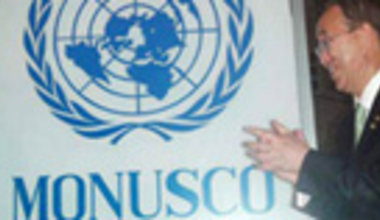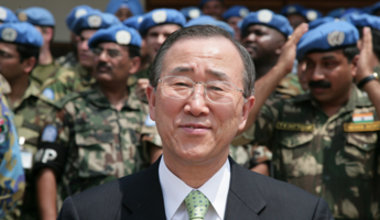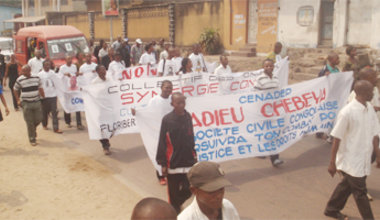MONUC WEEKLY PRESS CONFERENCE WEDNESDAY 11 NOVEMBER 2009
Madnodje Mounoubai, spokesperson: Good morning, ladies and gentlemen
In view of recent developments that have caused further debate on the role and action of MONUC to protect civilians, support the FARDC and the efforts to eliminate the threat of armed groups, we will devote this press conference to an update on the deployment and action of MONUC in general. We have therefore asked the MONUC Force Commander, Lt. General Babacar Gaye, to provide an update of the deployment and actions of the Force to help the media better understand and assist them in their task.
MONUC Force Commander:
Good morning, ladies and gentlemen and to all our listeners.
I would like, as Mr. Mounoubai explained, to provide you with a brief update on the situation of the Force and the various operations under way. You know we have received a significant reinforcement made up primarily of troops, but also of police units as well as [military] training personnel. We believe that, by the end of November, that is to say within a few days, most of this increase will be in place, because we have received, as you already see an additional battalion -- the Bangladeshi battalion - and two companies of Special Forces, one Jordanian and one Egyptian. In the month of December, we will receive the bulk of the Egyptian battalion, and we will have only to receive, at the beginning of January, a Bangladeshi engineering company and [two] Uruguayan helicopters. So, in sum, what we can say is that while the deployment of this reinforcement will have taken some time, it is essentially in place.
The face of the Force, once this new deployment is complete will be, as you can see, a force mainly composed of troops from Asian countries, but of which 28% of its troops are from Africa and slightly less than 10% from Latin America. There will be a total of 21 troop-contributing countries, but some fifty nations are represented, since there are countries that provide Military Observers and Staff Officers. The top five contributors are India, Pakistan, Bangladesh, Uruguay and the Republic of South Africa. These countries also bring with them considerable equipments, mainly thirty helicopters and not less than 350 armoured vehicles.
These troops will be deployed mainly in the eastern Democratic Republic of Congo. Approximately 90% of these forces are deployed in the east, in what was previously the area of responsibility of the Eastern Division. In the Kivus alone, you have close to 68% of the Force deployed in North Kivu and South Kivu. We can therefore say that the concentration of our forces in the East, which had been requested of us by the Security Council, has been done. This is no small feat when you consider that deploying a battalion requires no less than 3 to 4 months. But this is done.
Today, what is the status of major operations in which the Force is working alongside the FARDC? Before making this assessment, operation by operation, we could say that, paradoxically, at a moment when the suspension of assistance to a battalion of the FARDC, various human rights violations, and accusations surface that MONUC is assisting Mudacumura's departure; it's paradoxical at this moment when all these things create a sense of disorder, that operations in the field have seen considerable progress. Take, for example, Operation Rudia II, which followed Operation Lightning Thunder. Today it has been accepted by all parties involved that some 50 to 100 members of the Lord's Resistance Army (LRA) remain on Congolese territory. Of course, some of them have moved into the Central African Republic, but there has still been notable progress. And it is an opportunity to salute the performance of the Republican Guard, which was deployed for six months in Haut Uélé, and which has now been pulled out; everyone has acknowledged that it conducted itself fairly well.
Today, MONUC is present in the Upper Uélé in three positions-Dungu, Duru and Faradje - and in Bas Uélé at Isiro where there is a logistics base, and in Dingila.
As for the LRA, it is still present, of course, on the border between the Democratic Republic of Congo and the Central African Republic, but also in the area around Faradje. Almost every week there are surrenders of LRA members, including some commanders, or clashes between FARDC and the LRA, and that many members of the LRA are being neutralized and people abducted by the LRA manage to escape.
Regarding Ituri, there is, of course, residual violence, mainly due to the FRPI. MONUC, after consultations with various stakeholders on the ground, closed its base Kuandruma is currently strengthening its presence in the territory of Irumu. This will allow improvement in the security of people in this area where, you know, we just inaugurated the [restored] Mambasa bridge. This is an important development for the people.
I turn now to the situation in the Kivus provinces. Looking at the situation, both in North and South Kivu, what is positive is that all the FDLR strongholds were dismantled. Of course, there are still areas where small groups of FDLR operate. Their actions are principally three types: first, the harassment of people and attacks on FARDC positions and, finally, kidnapping for ransom.
With regard to MONUC, you see in the [Powerpoint] slide that is presented the string of positions —37 in total — that allow us to provide, to the best of our ability, protection for the population, but also to bring our support, particularly logistical, to the FARDC. It nonetheless is important to note that, beside the situation relating to the FDLR, there are still Congolese armed groups whose situation has still not been resolved definitively. This is the case, for example, of the Yakutumba group, whose leader had presented himself to the FARDC [for integration], and then returned to the bush. This is the case of APCLS. So there are, in any case, situations that fall within the domain of DDR. Gradually, I think, either through discussions or through increased military pressure, solutions will be found. But so far, the situation in the Kivu provinces is not settled definitively. Clearly, it is difficult to completely defeat an armed group. It's necessary now to ensure the safety of areas from where the FDLR has been expelled.
So we're in a situation where an assessment of the situation is needed in such a way that we can work on a new basis; say, for example, at the beginning of next year to ensure that we contribute, with FARDC, to protecting the population, but especially to eliminate the FDLR. So this is the brief overview of the situation to give you before taking your questions.
MONUC Spokesperson:
To add a word regarding logistics provided by the various civilian services of the Mission: MONUC transport and communication systems support MONUC troops at the same time as they provide support to FARDC. These services contribute to the transport and re-supply of nearly 30,000 troops involved in three different military operations in an area that extends from northern Katanga to the far North-east. MONUC provides the FARDC with 27,000 daily rations and, each week, about 37,000 liters of fuel in addition to transporting troops and equipment, providing medical evacuation when needed, as well as other services.
As an example of the logistical work of the Mission, I would like to note that in addition to its military and civilian personnel MONUC has transported over 33,497 non-MONUC passengers between January and October 2009. Among them were Congolese authorities, Congolese and international NGO representatives, bilateral partners of the DRC, representatives of UN agencies and so on.
Launch of the Fund for Stabilization and Recovery of the DRC
I would also like to draw your attention to the launch by Prime Minister Muzito in the presence of the Special Representative of the Secretary General of the UN in the DRC, Alan Doss on Friday 6 November, of the Fund for Stabilization and Recovery in the DRC (STAREC). The implementation of Government Plan for Stabilization and Reconstruction of areas emerging from Armed Conflict (STAREC) has progressed to a higher phase.
The sectors targeted by this fund are: the rehabilitation of training centers for the FARDC; the construction of housing for FARDC dependents and families; community reintegration of ex-combatants; support for deployment of the Police Nationale Congolaise (PNC) in strategic areas; support for war wounded; establishment of trading centres in mining areas and, finally, support for the STAREC coordination structure.
These projects are in addition to 15 others already being executed at a value of $138 million contributed entirely by the international community.
The initial amount of the Stabilization Fund is $20 million provided by the United Nations Peacebuilding Fund. In addition, the first bilateral contributions come from the Netherlands and Belgium, which have announced contributions of $2.7 million and €6 million respectively.
MONUC and the UN system as a whole have played a central role in developing this plan and today the establishment of this fund which will enable its implementation.
 UN
UN United Nations Peacekeeping
United Nations Peacekeeping



